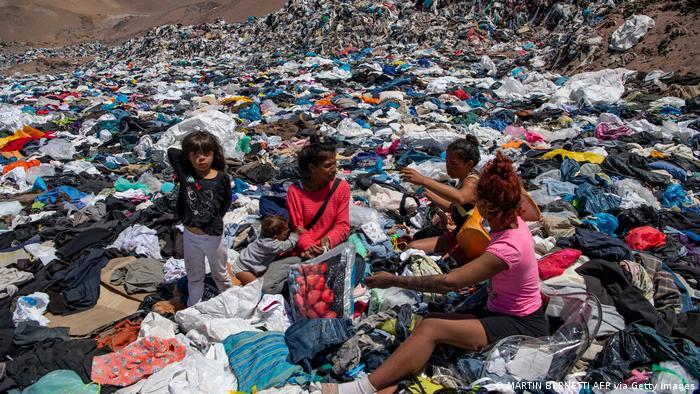04
01/2023
Every once in a while, when it rains a lot, the driest place on earth turns into a kind of sea of flowers. However, the patches of color that flood the Alto Hospicio commune in Chile's Atacama desert are not wonderfully scented flowers, but used clothing. Thousands of pants, shirts, jackets and other clothing are piled up in mountains that ruin the landscape of the hills.
Chile is one of the largest importers of used clothing in Latin America. As explained to dpa by the president of the region's business association, Darío Blanco, until October 2021, 29,178 tons of used clothing arrived in the nearby free zone of Iquique.
Bales of merchandise are unloaded at the port. Some 50 importers sell the best garments and the rest, approximately 40 percent, is thrown away.
"This clothing is discarded on the hills of our municipality," Edgar Ortega, the person in charge of the Environment at Alto Hospicio, told dpa. Up to 20 tons of old clothes end up every day in this unique natural paradise, and this has been going on for years.
The environmental organization Greenpeace stressed that the biggest challenge for the fashion industry is the large volumes of clothing generated by disposable fast fashion.
The inhabitants of Alto Hospicio see themselves as the last link in a chain, in which items are produced in China, consumed in Europe or the United States, and disposed of in Chile.
According to Estefanía González, from Greenpeace Chile, the fact that this happens in the Atacama desert is based on the idea that the desert is an empty place.

"As part of our campaign, we want to show that the desert is full of life and raise awareness about sustainable purchases", highlights the ecologist.
Ortega assures that the commune of Alto Hospicio barely has the financial and personal capacity to prevent spillage of clothes, much less to eliminate them. The Chilean official reveals that they have only five inspectors to catch those who throw away old clothes in the desert.
"The problem arises much earlier," he says. According to Ortega, the fact that clothing from other countries is not declared as textile waste means that it is not precisely determined how imported merchandise should or can be disposed of. "Until this is resolved, we will not be able to change the situation."
Camila Palma is hurt when clothes are labeled as garbage. She owns one of the many second-hand shops in the capital, Santiago de Chile.
@TNorrisYZF So I'm guessing you have zero doctor friends? Cause doctors would sorely disagree with you that they co… https://t.co/Y9xWu3Sz6I
— Don't be a Querdenker Fri Jul 09 16:16:26 +0000 2021
Due to the great competition, many stores have specialized, such as "Angora Vintage", in the charming European-style Paris-Londres neighborhood located in the center of Santiago, which is dedicated to the fashion of the 60s , 70 and 80.
Camila loves clothes made in Germany. "It is of very good quality, with good fibers and good fabrics. I like how a garment is made," emphasizes the 35-year-old fashion designer.
"Angora Vintage" does not buy bales. Select clothes in markets and fairs. "Now the clothes contain a lot of plastic, that's the problem," says Camila. That is why he prefers to choose 100% cotton vintage garments so as not to pollute the environment every time he washes.
"This is very important to have a sustainable store", he highlights. According to Greenpeace data, a polyester garment can release up to a million microplastic fibers in a single wash.
The environment in Alto Hospicio is also polluted by burning clothes to create space. "Normally there is a big fire a year," says the person in charge of the environment, Ortega. Firefighters try to extinguish the fire, but the fire continues to burn for days.
All this may not fit in Chile, which has meanwhile said goodbye to plastic bags in stores or has a recycling law based on the European model, which forces companies to take charge of the waste they produce .
Alto Hospicio, for example, formed a working group with the Chilean Ministry of the Environment to include used clothing in this recycling law.
Beyond a legal obligation, the president of the region's business association calls on importers to assume corporate responsibility for the garbage problem. "We will look for the formula to recycle discarded clothing," says Blanco.
For its part, the company Ecofibra de Alto Hospicio is already converting old clothes into insulating material. So far it can process three tons per day.
Blanco hopes that importers will either provide more machines to Ecofibra or look for other alternatives. "What is clear is that they have to take care of the textile waste and that they cannot continue throwing it away," he emphasized.
dpa

- 581
- how to make fashion with old clothes
Related Articles
48 Best Kids Watches in 2021 based on 623 reviews
16/05/2022If you are here, we assume that you are looking for the best watches for children. However, given the number of options available in the market, it becomes really daunting to choose the right product...
46 Best Pitchers and Decanters in 2021: According to the Experts
20/04/2022You can get any random Pitchers and Decanters, but if you're looking for expert advice to choose the best one for your needs, then you've come to the right place. No matter which...
39 Best Legumes in 2021: According to the Experts
02/03/2022You can get any random legume, but if you're looking for expert advice to choose the best one for your needs, then you've come to the right place. No matter what your...
Best Camper Kit For Vans 2022 (buying guide)
03/05/2022Technology improvement need only increase the level of competition in each market. Whether it is automobiles or electronic devices, every industry makes the best use of advanced technology...